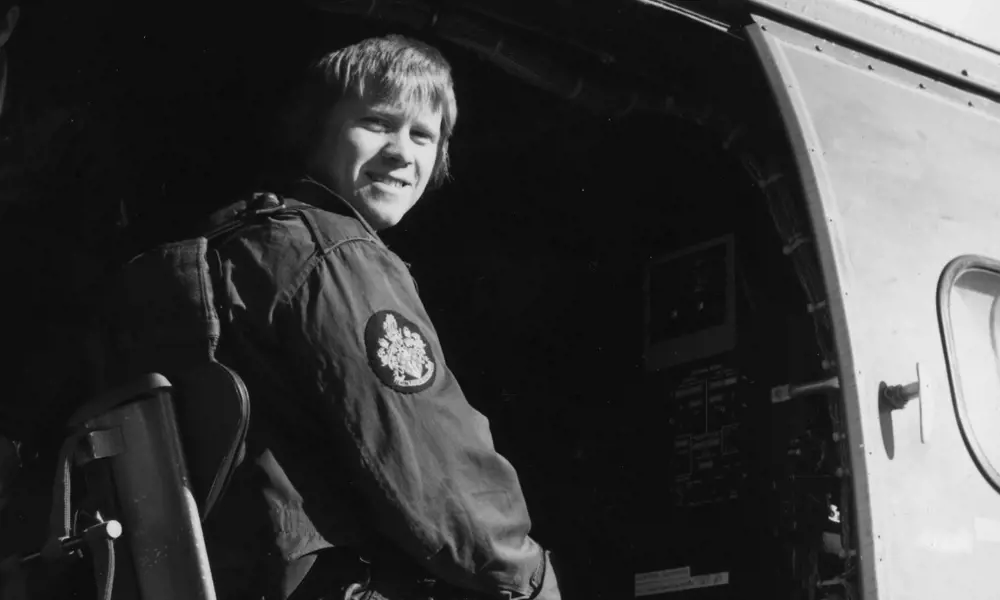
The helicopter flight fixer
Had he achieved his schoolboy ambition, Philip Dunford FREng’s aviation experience could have been limited to family holidays and flying to matches as a superstar football player. He attended trials at Southampton and Reading, before mechanical engineering intervened. While he remains a supporter of ‘The Saints’, his own sporting ambitions “didn’t pan out”, as he puts it. When his father urged him to “get a real job”, Dunford looked locally. The family lived near to the Ministry of Defence aircraft testing site Boscombe Down, which is where Dunford’s career started to take off.
Dunford began as an apprentice, learning how to keep aircraft flying for the Royal Air Force (RAF). It was a traditional apprenticeship that mixed practical and classroom work, including time spent in a workshop at Porton Down making his own tools. When his father’s job took the family to Bedford, Dunford switched his apprenticeship to RAE (Royal Aircraft Establishment) Bedford to work towards a Higher National Certificate in Engineering.
Although he qualified to start working as a mechanic, Dunford wasn’t ready to quit education. “As soon as I finished, for some reason, the government came up with this initiative to send who they considered eligible people who hadn’t got their A levels to college,” he says. Dunford opted for a degree in mechanical engineering at Brunel University. “They paid me a full salary to go to university for four years.”
Dunford began as an apprentice, learning how to keep aircraft flying for the Royal Air Force (RAF). It was a traditional apprenticeship that mixed practical and classroom work, including time spent in a workshop at Porton Down making his own tools.
Returning to the air
Afterwards, Dunford wanted to “get back into airplanes”. Now a bit older and wiser, he returned to Boscombe Down to work on helicopters in D Squadron. Soon after, he was singled out for the prestigious Empire Test Pilots’ School (ETPS). Pilots from around the world came to the ETPS to learn to test different aircraft. Dunford was there to learn to be a flight test engineer. “It was a big deal for me,” he says.
Dunford describes his time at ETPS as “the hardest year of my life”. He still has a class photo of his year group lined up in front of two fighter aircraft, where Dunford stands out as the one with a ‘70s haircut in the middle of a row of uniformed pilots. “There are not too many civilians in there,” he jokes.
Back then, he explains, test engineers, known to the pilots as ‘talking ballast’, flew in the aircraft with the pilots. There was only one fixed-wing test engineer at ETPS that year. “So, I got to fly in all the fixed-wing aircraft and the helicopters, and I learned a lot about both. The test-pilot school was a really, really good experience.”
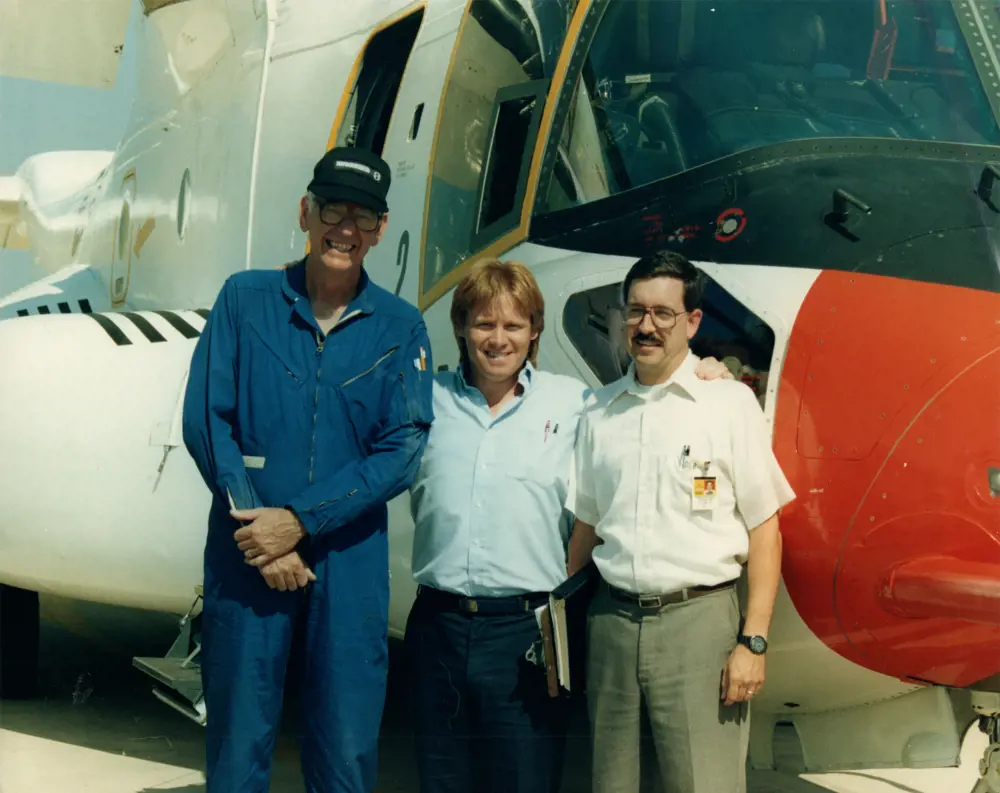
Phil Dunford with colleagues before the first flight of the V-22 Osprey aircraft.
Dunford’s time at pilot school proved invaluable when he wanted to move on to new engineering challenges. “It set me up for the rest of my career,” he explains. “It was the leverage that I needed to differentiate myself, because in those days not many engineers had done the course.”
As he describes it, the test engineer’s role with the UK Ministry of Defence was essentially to pick over the planemakers’ work. “You were checking everything that the manufacturer had done first,” Dunford explains. He wanted to be in at the beginning of the aviation development engineering process and to work on new aircraft. So, when Boeing’s vertical take-off and landing (VERTOL) division in the US advertised for test engineers, Dunford applied. In a short time, Boeing flew him to the US and offered him a job. Dunford credits his ETPS training with tipping the scales in his favour. “None of the engineers in their organisation had a test-pilot school background so it was kind of a shoo-in.”
Dunford’s first assignment with Boeing was to work with some previous colleagues at Boscombe Down. They conducted natural icing testing on the RAF Chinook in Shearwater, Canada. “We took the aircraft to Nova Scotia and, after a long flight in freezing rain over Prince Edward Island, we broke the record for the amount of ice grown on a helicopter in a single season.” The Chinook tests went well. Dunford became an expert in helicopter icing, writing several papers on the subject and the UK still does icing tests in Nova Scotia. Unfortunately, his boss had stuck a Canadian Maple Leaf emblem on the front of the Chinook, which upset the RAF Wing Commander who had funded the tests. Following the officer’s intervention, the maple leaf disappeared from the photos that appeared in the press.
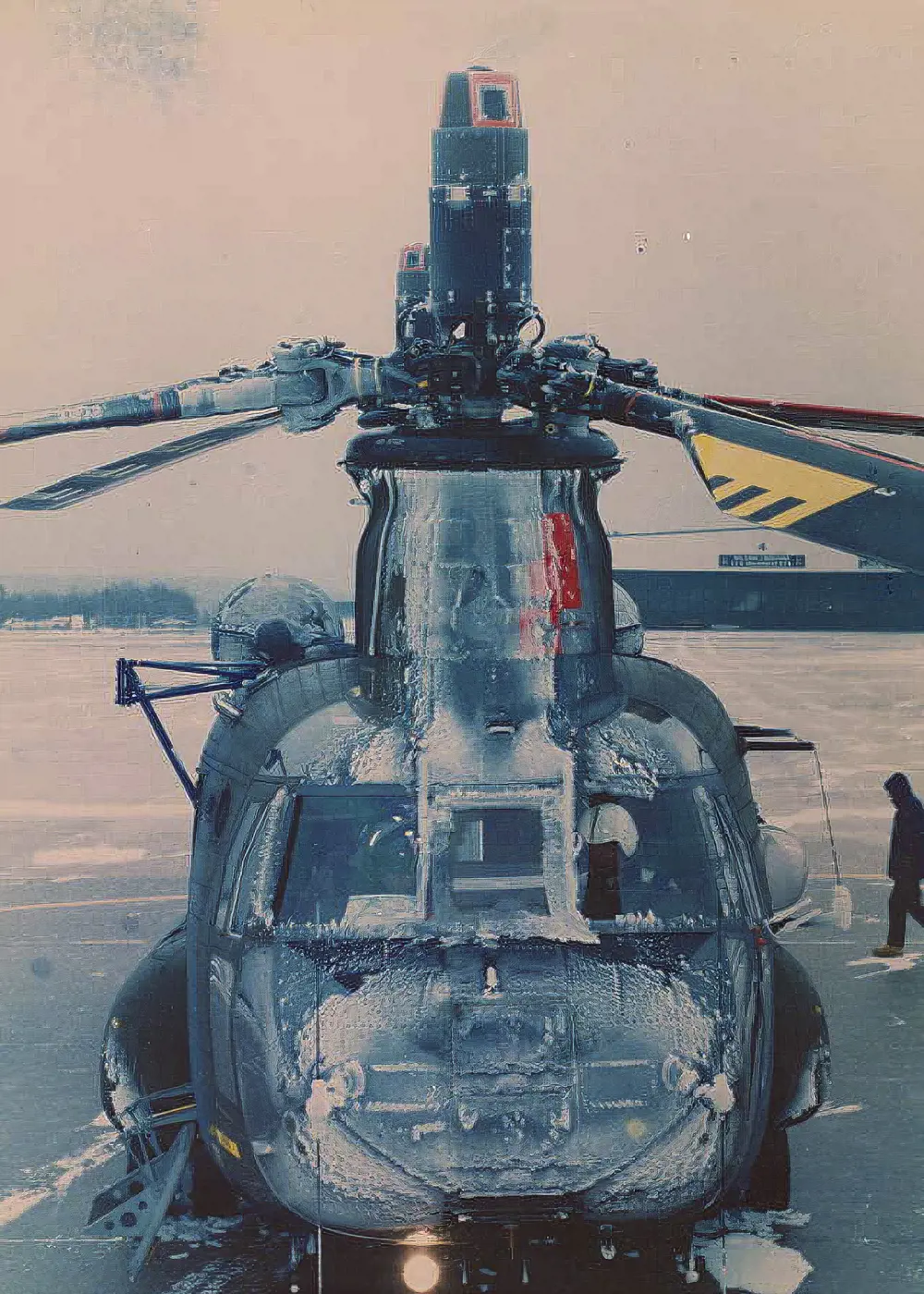
The Chinook after the flight in freezing rain over Prince Edward Island, with the record-breaking amount of ice on it
Dunford can reel off similar anecdotes by the dozen, such as the time when food poisoning interrupted sonar trials with French Navy helicopters. Waiting for the sea to get suitably choppy, the test team went out for a seafood dinner that turned out to be bad. The two pilots got sick: one had to go to hospital. “We didn’t get to fly that day, even though the seas were what we wanted.” The tests, when finally completed, revealed worrying instabilities. “We had a big fight with the French test agency over our conclusions. In the end they actually changed the system based on our recommendations.”
The next memorable incident was, he says, “some of the scariest tests I’ve done in my life”. The tests, which were preceded by underwater escape training at HMS Vernon’s infamous dunker, were in Lynx helicopters flying off Royal Navy ships HMS Coventry and HMS Avenger, in rough seas and high winds to develop operational flight envelopes for the Navy.
Dunford recalls another less scary “dunking” test. A Boeing 234 sank after it had to ditch in the North Sea. British Airways had bought six model 234 Chinooks to fly crews out to North Sea oil rigs. “The Civil Aviation Authority would not let the airplane fly until we could prove that we understood its floating capabilities.” The engineers also had to show that they could seal the helicopter to prove that it wouldn’t sink. “I had to calculate the buoyancy of the aircraft,” he explains. Along with two pilots, “we dumped the airplane into the Delaware River and shut down the rotors to see how good our predictions were”. Dunford had painted a ‘water line’ on the fuselage to show where he thought the helicopter would float. “It turned out to be pretty good.” The crew successfully managed to restart the aircraft and take off from the water.
The engineers also had to show that they could seal the helicopter to prove that it wouldn’t sink. Along with two pilots, “we dumped the airplane into the Delaware River and shut down the rotors to see how good our predictions were”. The crew successfully managed to restart the aircraft and take off from the water.
Flying from the ground up
How engineers developed a new generation of VTOL aircraft
Philip Dunford achieved his ambition to get stuck into developing a new aircraft from the ground up when he joined the engineering team building the V-22 Osprey. In his time on the aircraft, Dunford moved up the engineering hierarchy, taking on such roles as technology manager, flight test director, chief engineer and, finally, programme manager.
The V-22, a joint venture between Boeing’s defence business and Bell Helicopter, was a new generation of VTOL aircraft. With its tilt rotors, the Osprey was the world’s first hybrid, a cross between a helicopter and a fixed-wing aircraft.
The project grew out of a disastrous military mission in Iran. A hostage rescue went wrong, with several helicopter crashes. The US Marines wanted a more versatile VTOL aircraft for situations where neither helicopters nor fixed-wing aircraft were ideal. The aircraft’s novel tiltrotor configuration means that the V-22 can take off vertically, tilt its rotors forward, and turn into a faster, fixed-wing machine with a longer range and higher operating ceiling.
Dunford joined the V-22 as flying qualities engineer. He worked on aerodynamics, propulsion and preflight wind tunnel testing, as well as working on the ‘fly-by-wire’ flight control system. The tiltrotor arrangement created fresh engineering challenges. For example, the engineers had to deal with a complicated pattern of airflow around the V-22, with downwash from the rotors and the Rolls-Royce jet engines that powered the rotors.
Then there was the not-so-small matter of two jet engines pointing downwards, with their hot exhaust threatening to damage the deck of any ship that they flew from. Dunford says of his role: “As the design progressed, I helped the aerodynamics and loads departments calculate the initial loads used to design the horizontal and vertical tail and worked with Northrop Grumman – the first producers of the horizontal tail.”
Using systems engineering to address the V-22's challenges
The V-22 was a combination of subsystems that had to come together in the finished product. It was around this time that Dunford developed his thinking on how to manage complex engineering projects. Now recognised as a discipline in its own right, systems engineering deals with a programme in its entirety.
Dunford turned to systems engineering to deal with the high-profile problems, including fatal crashes, that had hit the V-22 in its early stages. In partnership with his NAVAIR (Naval Air Systems Command) counterpart, Dunford’s approach to solving problems “included ensuring we followed a strict systems engineering approach to testing from start to finish, aggressive requirements management, risk and safety management, developing a ‘fly before you fly’ approach using extensive simulation and data analysis to support flight test, as well as extensive ground testing of the flight vehicle prior to flight”.
As with many engineering projects, it was important to understand and measure what was going on. “We also micromanaged key metrics and knowledge points in the test programme, which eventually became the drivers of higher flight test productivity.”
Dunford, by then in charge of the whole test programme, was gradually moving from hands-on engineering to a leadership role. Not only was he running large teams of engineers, he was also dealing with politicians. “Technically I was still engaged in [engineering], but I was one of the guys strategically guiding the programme.”
When it came to dealing with what Dunford labels an “operational pause” – when the team had to spend a year or so recovering from a couple of fatal accidents – he had to immerse himself in the world of politics to explain the Osprey’s engineering issues to government paymasters. Had that gone wrong, he explains, there was a chance that they would have cancelled the whole V-22 project.
Dunford knew that he had to come up with a strategy that would convince the US Department of Defense to continue the programme. He sat down and scribbled a return to flight strategy on a single sheet of paper. This eventually became the slide that explained the issues that faced this new type of aircraft to senior government personnel while offering a solution to the predicament.
It worked. The Osprey, which first flew in March 1989, eventually completed its first operational evaluation in 2005 when the Pentagon approved full production of what was the world’s first production tiltrotor aircraft. With a fleet of more than 400 operated by the US Armed Forces, the Osprey V-22 has sold around the world and given rise to several variants, most recently the MV-22B version for the US Marines.
Systems thinking for hybrid aircraft
Dunford achieved his ambition of being involved in the engineering of a new aircraft when he joined the team working in the V-22 Osprey, a new kind of aircraft, a hybrid between a helicopter and a fixed-wing aircraft [see ‘Flying from the ground up’]. The Osprey accounted for the next 15 years of Dunford’s career, starting as a Flying Qualities Engineer, assessing the flying characteristics in the first simulations of the proposed aircraft. During that period Dunford had to deal with problems that threatened the whole Osprey programme. A lot hung on the V-22. It was one of the biggest development programmes in the US Department of Defense at the time.
It was while working on the V-22 that Dunford began to experience the role of politics in aircraft development. Always a controversial programme, with its roots in military failure, Dick Cheney, the then Secretary of Defense, was keen to cancel the Osprey, with its ever rising cost and technical challenges. “The development issues always made it a target for cancellation,” says Dunford. The project faced a rocky political future, with various attempts to cancel the V-22.
His various roles on the V-22, rising to become Boeing’s Program Manager on the joint venture, gave Dunford valuable experience in troubleshooting. His growing reputation on this front led to the role of Chief Operating Officer (COO) of Boeing military aircraft. “That really was a troubleshooting job.” It wasn’t his job to worry about the bottom line but to look at all of the business’s programmes and their engineering issues. “I don’t think you ever lose the engineering side of your character. It’s always there.” With a dozen or more aircraft and systems to play with, from fighters to helicopters and weapons systems, Dunford was flying all over the place.
This was another opportunity for Dunford to spread the word about his growing enthusiasm, developed on the V-22, for the role of systems thinking in managing large complex engineering ventures. “I was big on the systems engineering approach to development,” he explains. “The army really embraced it when Boeing asked them to follow a very detailed systems engineering approach on the successful Apache Block III development programme.”
I don’t think you ever lose the engineering side of your character. It’s always there.
Philip Dunford FREng
Quick Q&A
🚁 From slide rules to the Burj Khalifa, Philip Dunford's engineering icons
What inspired you to become an engineer?
The TSR 2 flying over my house in Amesbury, Wiltshire, during its brief test programme before cancellation.
What’s your advice to budding engineers?
Get a technical integrity tattoo. Make systems engineering part of your modus operandi. Remember that the higher up the totem pole you go, the more your butt shows.
Best bit of the job now?
Working with young engineers during my consulting roles. This includes my daughter who is in her senior year at the Schreyer Honors College at Pennsylvania State University. Working on my Execution Excellence book.
Most admired historical engineer?
Isambard Kingdom Brunel; I went to his namesake university.
Do you have a favourite tool/tech gadget?
Slide rule. Still have mine from university.
Which engineering achievement couldn’t you do without?
The helicopter. Both from a personal, a military, commercial, and humanitarian perspective.
Most impressive bit of engineering to look at?
Burj Khalifa, United Arab Emirates.
Overlooked engineering successes?
Sydney Darlington, Bell Labs – the inventor of the Darlington Pair (a multitransistor configuration) and the precursor to integrated circuits
The US Army was also in Dunford’s sights when, as Vice President/General Manager of Boeing Rotorcraft, he served two terms as President and Chair of the American Helicopter Society. (It changed its name to the Vertical Flight Society in 2018.) One of the society’s roles is to make the case for ‘rotorcraft’ in policy circles. As Chair, Dunford deployed his “bigger picture” approach to thinking about another challenge. He pointed out to the US Army that over the years the army hadn’t commissioned the sort of clean drawing board exercise that led to the Osprey more than two decades earlier.
“They had an ever-decreasing number of new-start aircraft, and a lot of derivative modifications of aircraft that already existed and some of those aircraft were cancelled because of performance difficulties in the development programmes.”
Dunford reckons that things have changed in the decade since he made that pitch. “I’m sure it’s just not me that’s driven this, but the army have changed that around now. They have initiated two exciting new helicopter programmes. They are actually doing all the things that the industry needed them to do, spending money on developing new capability."
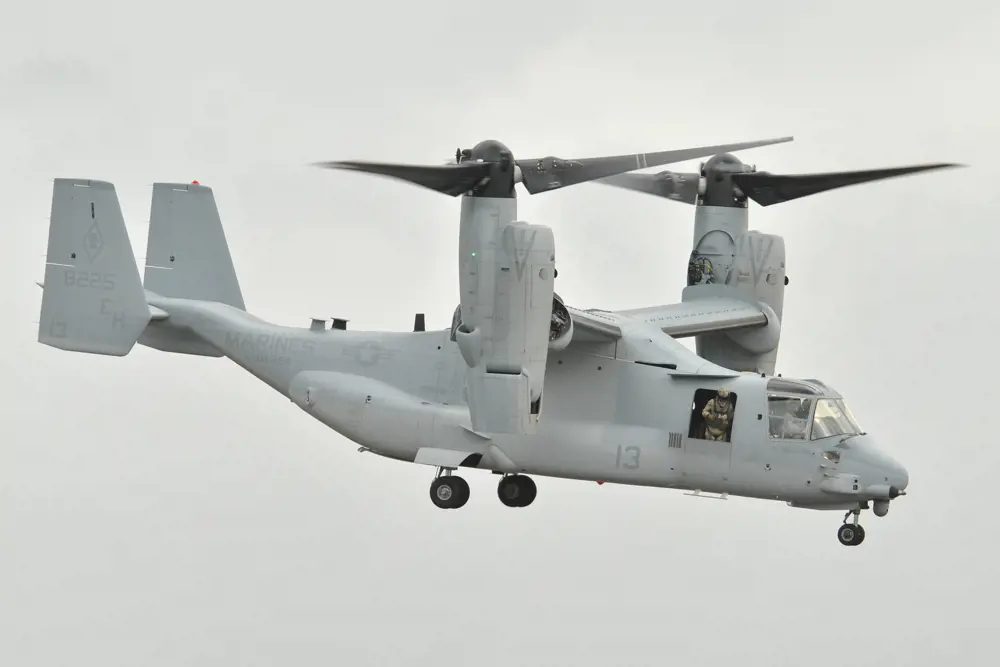
Dunford’s first flight in the V-22 Osprey finally happened at the Farnborough Air Show in 2012. Again, Boeing had the Osprey on show, this time with the US Marine Corps in the driving seat. “They said to me, ‘We’re going to Boscombe Down to the test-pilot school, would you like to fly with us?’. We went up to the pilots’ briefing room, had coffee and then went home. It was a great experience.”
Career timeline and distinctions
Apprentice mechanical engineer, 1968–1972. Mechanical engineering, Brunel University, 1972–1976. Flight test trials officer, Boscombe Down, 1976–1979. Graduate flight test engineer, Empire Test Pilots School, 1977. Joined Boeing Vertol (US), 1979. Various roles on the V-22 Program, 1984–1998. Director, Boeing Vehicle Systems and Technology, 1998–2000. Fellow, American Helicopter Society, 2004. Director Rotorcraft Engineering, 2004–2005. V-22 Program Manager, 2005–2006. Vice President Rotorcraft Operations, 2006–2008. Vice President/General Manager, Boeing Rotorcraft, 2009–2010. Fellow, Royal Aeronautical Society, 2010. Chief Operating Officer, Boeing Military Aircraft, 2010–2015. Honorary Fellow, American Helicopter Society, 2014. Fellow, Royal Academy of Engineering, 2019.
Teaching the pilots and engineers of the future
It wasn’t long before Dunford returned to Boscombe Down, this time as the guest speaker at the ETPS’s graduation dinner, 30 years after he graduated. “I was very honoured to be asked to make that presentation.”
Dunford has taken to lecturing pilots in general. For example, at the Society of Experimental Test Pilots in Los Angeles, he made the point that test pilots need to be more involved in the development process. “Pilots would just go fly, come back, and wait until they go fly again. They’re engineers at heart. They have a lot of skill, they have a lot of engineering capability, they understand what it is that they’re flying. I think there’s room for them to be engaged in the early design of the aircraft.” His message to pilots is, as he puts it, “be more of a geek and less of a jock”.
As well as advising pilots, Dunford has made a point of mixing with students. When working on the V-22, he developed a course on it for engineering students at Caltech (the California Institute of Technology). “Telling them everything that we knew about an aeroplane that wasn’t yet in production was quite an interesting situation. It was fun to do, especially at Caltech.”
Dunford’s career started in an era where the engineer’s toolkit also included a slide rule. He is in awe of some of the tools available to today’s students. Digital tools haven’t just killed the slide rule, they have changed the whole development process. “The biggest change probably is the move to digital design and development, to the point now, where companies are building digital copies of their products, what they call digital twins of the product. The whole development cycle is now digitised and we’re able to do things on the desk before you go fly.” However, Dunford advises today’s engineers to look beyond these tools. “They would also be wise to understand the principles of systems engineering.”
***
This article has been adapted from "Fixing to fly", which originally appeared in the print edition of Ingenia 92 (September 2022).
Keep up-to-date with Ingenia for free
SubscribeRelated content
Aerospace

ALMA – the high altitude observatory
The Atacama Large Millimetre/submillimetre Array (ALMA) is the largest and most expensive ground-based telescope built, revolutionising our understanding of stars and planetary systems. Building it in the Atacama Desert in Chile required the ingenuity of hundreds of engineers.
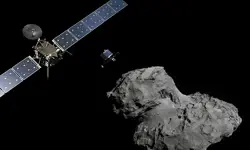
Communicating with outer space
The Royal Academy of Engineering awarded a team at BAE Systems the Major Project Award in June 2016 for their development of a powerful satellite modem system, pivotal in enabling the precise control of the pioneering Rosetta spacecraft and the first-ever soft landing of a spacecraft on a comet.
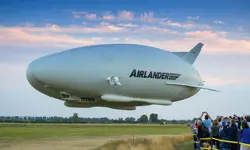
An aircraft like no other
The Airlander made headlines when it embarked on its first test flight in August 2016 as the world’s largest aircraft. Chris Daniels at Hybrid Air Vehicles Limited, and David Burns, Airlander’s Chief Test Pilot, talk about the engineering that helped it reach this stage and plans for the craft’s future.

Q&A: Lucy Harden
Lucy Harden is a mechanical engineer on BAE Systems’ Digital Light Engine Head-Up Display development programme. She devises innovative solutions for pilots to display essential flight information that sits directly in their line of sight and is overlaid onto the real world.
Other content from Ingenia
Quick read

- Environment & sustainability
- Opinion
A young engineer’s perspective on the good, the bad and the ugly of COP27

- Environment & sustainability
- Issue 95
How do we pay for net zero technologies?
Quick read

- Transport
- Mechanical
- How I got here
Electrifying trains and STEMAZING outreach

- Civil & structural
- Environment & sustainability
- Issue 95